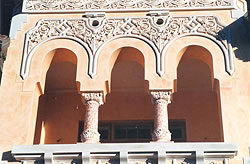Decorative Paint, Lime wash
Natural pigments in lime will hold their color, whereas non-organic or synthetic tints tend to lose their color. But even with the natural products, you'll get variations in color from the natural aging that will happen over time.
by Stacey Enesey Klemenc
From King Tutankhamen’s tomb in Egypt and the temples of Mesopotamia to the Acropolis of ancient Greece and the Coliseum in Rome, the ancients used lime wash and lime-based plaster, mortar and stucco to help create monuments that have gracefully withstood the test of time. Today, savvy professionals are rediscovering what some believe was the first true paint and are using lime wash to recreate that classical look of yore.
Although the ancients leaned toward white or off-white lime wash, lime-based paint today is often an earth tone achieved with natural ground pigments. “Natural pigments in lime will hold their color, whereas nonorganic or synthetic tints tend to lose their color,” says Barth White, president of Barth’s Faux Finishing in Las Vegas, a firm that specializes in decorative finishes and scenic painting. But even with the natural products, “you’ll get variations in color from the natural aging that will happen over time.”
 Raymond Sandor, CEO of Faux Effects Inc. in Vero Beach, Fla., a company that develops and manufactures decorative and faux finishes and also provides in-depth training through various workshops, stresses: “These colors should be dry natural Earth oxides, not synthetics. Colors other than oxides will burn because of the high pH present in the lime. Synthetics won’t last. They don’t play nice in lime paint.” Raymond Sandor, CEO of Faux Effects Inc. in Vero Beach, Fla., a company that develops and manufactures decorative and faux finishes and also provides in-depth training through various workshops, stresses: “These colors should be dry natural Earth oxides, not synthetics. Colors other than oxides will burn because of the high pH present in the lime. Synthetics won’t last. They don’t play nice in lime paint.”
Lime paint can be applied over most water-based or flat oil-based painted surfaces, drywall, stucco or raw wood. Smooth surfaces work best, White says, and most true lime-based paints — there are many on the market today that are only 20 percent to 30 percent lime combined with resins — require a primer “to make sure everything marries well together.”
Sandor also recommends a primer for most surfaces. “Lime paint grips best to flat paints or raw stucco, stone or brick. If it doesn’t have enough tooth, it could scale off.”
 |
 This museum near Paris, France, was restored under the watchful eye of Barth's Faux Finishing. All work was done with lime-based paints and natural pigments This museum near Paris, France, was restored under the watchful eye of Barth's Faux Finishing. All work was done with lime-based paints and natural pigments |
After lime paint dries, it continues to leach, which brings out the oxidized color of the embedded lime material. “The color forms somewhat of a pattern by the simple fact of application,” Sandor says. When the paint ages, “Frosty white lime comes out of the material and you get a dead-flat, sun-bleached appearance you just can’t get out of any other paint. The colors have a tendency to almost ungulate; they don’t stay quite constant like in a normal paint. And even though the lime paint is pastel, it has a certain radiance, a unique depth of color that is so much more alive than a latex.”
With its subtle unevenness of color, irregular surface texture and great depth, the often-translucent lime-based paint is a natural, nontoxic product that has several redeeming qualities.
“Lime is vapor permeable,” White says. “It resists water condensation. It helps the walls breathe and expel dampness contained within. It also helps to save energy as heating is improved when dampness is removed.”
Plus, for the health-conscious, there’s another bonus: “Lime is a natural bactericide,” White continues, and also repels insects. “It purifies the atmosphere and kills molds.”
But lime’s positive attributes don’t stop there. It’s waterproof, wears great inside or out, combines well with natural earth pigments, is able to withstand variations in temperatures and practically lasts forever. And many contend that today’s modern coatings don’t hold a candle to lime’s illuminating good looks.
Lime is made by burning limestone or chalk, which are both forms of calcium carbonate, in a very hot kiln. The high temperature drives off the carbon dioxide, leaving calcium oxide or quicklime behind. Adding water, which is called slaking, to the quicklime creates a creamy lime putty. This putty is mixed with sand to form lime mortar, or with water and pigments to create lime wash.
When you mix slaked lime with more water and apply it to a surface, the lime slowly absorbs carbon dioxide from the air and forms crystals of calcium carbonate again. These unusual crystals have a dual-refractive index, which means the light that enters is reflected back twice. This reflective property is what gives lime-washed walls their glowing character.
There are two basic types of lime:
- Hydraulic lime, which usually comes in a powder, starts its drying process as soon as it is mixed with water, leaving little time to apply. It can’t be preserved more than a few hours even in closed buckets. This type of lime is usually mixed with coarse sand and is mostly used for masonry work.
- Nonhydraulic lime usually comes as a ready-to-use paste with the same properties as hydraulic lime, except it starts to dry only when it comes in contact with air (opening the drying time and increasing its workability). It can be stored months or years in closed cans even after use. This is the type of lime that’s used as the binder and serves as the hardening agent in lime-based paint.
Whereas both types of lime share a similar chemical make-up, the difference lies in the extent of refinement. “The lime in paint is not refined as fine as the putty but it’s hydrolyzed and washed and cleaned before it’s formulated,” says Sandor “Its pureness makes a lime a good lime.”
White says one European company he deals with puts the lime in big oak casts and stores it anywhere from 18 months to 3 years until it reaches a certain purity. Likening it to a good wine, he says, “It’s some of the finest product we get. It’s like working with butter, creamy and smooth. As a matter of fact, he adds, the lime that comes from this manufacturer is from the same line that Michelangelo used on the Sistine Chapel. Stateside as well as abroad — the Italians and French lead the market — the refining process is “very proprietary, very secretive,” notes Sandor, whose company manufactures Old World Lime Paint as well as a lime-based milk paint. “It’s a well-guarded trade secret how to liquefy lime and turn it into a paint that doesn’t turn rock hard in the can.” Neither man recommends trying to make your own lime paint. “You might get lucky, but most paints aren’t formulated to withstand lime’s high pH content,” Sandor says. “It’d be like playing Russian roulette.”
But there’s nothing tricky to making lime wash out of lime paint. The paint is thicker; the wash is more translucent. Other than that, they’re the same animal and most professional painters use both to create the Old World look they’re after.
“For the first coat, I use straight lime paint,” says White, who like most in the field applies the paint in a crosshatch pattern. “The second coat is more of a wash.” Roughly, he mixes two parts water to one part paint and brushes on the second coat while the wall is still damp. “This way I’m diffusing the original brush strokes. If I didn’t use water, the method of application would be very apparent. The second coat softens the whole piece.” He also uses a spray bottle filled with water to help bring out even more shades and to help the coating look mottled and aged. “Squirting the lime activates the pH, making the water come to the surface. It drags the lime along with it, which is what creates that beautiful patina, that chalky matte texture with a silky quality.” White stresses that the application of lime paint is very important. “If you use a roller, it will be obvious. If you sprayed it on, it would be too uniform. That’s why we like to brush it out.” Mike Hoppe, co-owner of Hoppe Brothers Faux Masters Studio in Yorba Linda, Calif., describes lime wash as “a very thin layer of a coating, much like a glaze but made with lime rather than an acrylic medium. It has a quality that you cannot duplicate with regular oil or water-based glazes and a depth you don’t find in other glazes. The sophisticated eye can detect lime wash in a heartbeat. It’s very translucent for how matte it is.” One word of caution: Although lime paints are extremely durable, painted surfaces are not washable because the lime reacts with water and watermarks will appear.
Just like an amateur sponge job, a lime wash not applied correctly can look very monochromatic, “like wallpaper,” says Hoppe, who believes in using a cheesecloth to pounce the color on the walls in a random pattern. Hoppe usually uses three different colors of lime paint for a typical job, one as an overall color, one for shadowing and one for depth. “We have spots where the color is very intense and lots of places where the color is gone, fallen off the wall. That’s the look we’re trying to get. We’re trying to make an interior wall look like an exterior wall of an old Italian villa.”
 |
 Lime paint goes on the walls at a Hoppe Brothers project. Lime paint goes on the walls at a Hoppe Brothers project. |
One of the attributes of lime wash or paint is that it dries to a much lighter color than what you see when you initially brush it on — at least 50 percent lighter.
“Lime wash dries so much lighter than what you see in a bucket,” Hoppe says. “Most people get frustrated because it’s so unpredictable. I’ve been there.”
Sometimes, he says, when he has trouble “hitting” his color and feels like he’s losing all the color when it dries, he switches from lime paint to an Aqua Color and water mixture. “It colors the lime and I don’t tend to lose my water stains,” he says about the remedy. “It still looks like lime paint. When it dries, the lime will still burn through that color but you won’t lose everything.” “Lime will leach for about 30 days in coastal areas where fog rolls in or there’s a mist,” says White of Barth’s Faux Finishing. This moisture works with the lime to create “a nice patina in no time at all. In the desert where we don’t get moisture, we have to apply water to the walls if we want that type of patina.” White says that lime-based paints have been gaining in popularity these last five years. “The wealthy and well-traveled knew about these things, but now it’s funneling down to the average homeowner. When I first started my business, most people didn’t even know what faux was. Now there’s a great demand for it.”

|

